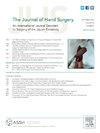Differences in the Incidence of Amyloid Deposition in Biopsies Performed During Bilateral Carpal Tunnel Release
IF 2.1
2区 医学
Q2 ORTHOPEDICS
引用次数: 0
Abstract
Purpose
Biopsy during carpal tunnel release (CTR) to assess for amyloid deposition may be indicated in older patients with bilateral symptoms. There is a paucity of prior investigations comparing the results of bilateral CTR biopsy samples. Our purpose was to compare differences in the incidence of amyloid deposition detected during bilateral CTR.
Methods
We reviewed primary, bilateral (staged or simultaneous) CTR cases from a single-surgeon between March 2022 and September 2024 during which a biopsy was obtained from both sides. The presence of amyloid deposition was determined using Thioflavin T and/or Congo Red staining using established institutional protocols. Baseline demographics were recorded, and the results of bilateral biopsies were compared to assess for disparate results.
Results
A total of 65 patients underwent bilateral CTR where a biopsy was obtained during both procedures. Mean age was 67 years, and 42% were women. Of the 65 included patients, 8 (12%) had evidence of amyloid deposition on at least one biopsy. Six patients overall (9%) had disparate biopsy results, accounting for 75% of positive cases. In these six patients, four (67%) had evidence of amyloid deposition during the first biopsy and no evidence of amyloid on the second biopsy. Two of six patients (33%) had no evidence of amyloid deposition during the first biopsy but did have evidence of amyloid on the second biopsy.
Conclusions
Biopsy results differ with respect to amyloid deposition in 9% of bilateral CTR cases. Seventy-five percent of patients with evidence of amyloid deposition on at least one extremity will have discordant bilateral biopsy results. In patients where the index biopsy is positive during a CTR, a contralateral biopsy may not be necessary. However, in patients where the index biopsy is negative for amyloid deposition, we recommend repeating the biopsy during the second (contralateral) CTR.
Type of study/level of evidence
Prognostic II.
双侧腕管释放术中活检中淀粉样蛋白沉积发生率的差异。
目的:在腕管释放(CTR)期间进行活检以评估淀粉样蛋白沉积可能适用于有双侧症状的老年患者。比较双侧CTR活检样本结果的先前调查缺乏。我们的目的是比较在双侧CTR中检测到的淀粉样蛋白沉积的发生率的差异。方法:我们回顾了2022年3月至2024年9月期间由单一外科医生进行的原发性,双侧(分期或同时)CTR病例,在此期间从两侧进行了活检。淀粉样蛋白沉积的存在是用巯基黄素T和/或刚果红染色确定的。记录基线人口统计数据,并比较双侧活检的结果以评估不同的结果。结果:共有65例患者接受了双侧CTR,在两个过程中都进行了活检。平均年龄67岁,女性占42%。在纳入的65例患者中,8例(12%)在至少一次活检中有淀粉样蛋白沉积的证据。6例患者(9%)活检结果不同,占阳性病例的75%。在这6例患者中,4例(67%)在第一次活检时有淀粉样蛋白沉积的证据,第二次活检时没有淀粉样蛋白沉积的证据。6例患者中有2例(33%)在第一次活检时没有淀粉样蛋白沉积的证据,但在第二次活检时确实有淀粉样蛋白沉积的证据。结论:在9%的双侧CTR病例中,淀粉样蛋白沉积的活检结果不同。75%至少有一侧肢体有淀粉样蛋白沉积的患者双侧活检结果不一致。在CTR期间指数活检阳性的患者,可能不需要对侧活检。然而,对于淀粉样蛋白沉积指数活检呈阴性的患者,我们建议在第二次(对侧)CTR时重复活检。研究类型/证据水平:预后II。
本文章由计算机程序翻译,如有差异,请以英文原文为准。
求助全文
约1分钟内获得全文
求助全文
来源期刊
CiteScore
3.20
自引率
10.50%
发文量
402
审稿时长
12 weeks
期刊介绍:
The Journal of Hand Surgery publishes original, peer-reviewed articles related to the pathophysiology, diagnosis, and treatment of diseases and conditions of the upper extremity; these include both clinical and basic science studies, along with case reports. Special features include Review Articles (including Current Concepts and The Hand Surgery Landscape), Reviews of Books and Media, and Letters to the Editor.

 求助内容:
求助内容: 应助结果提醒方式:
应助结果提醒方式:


